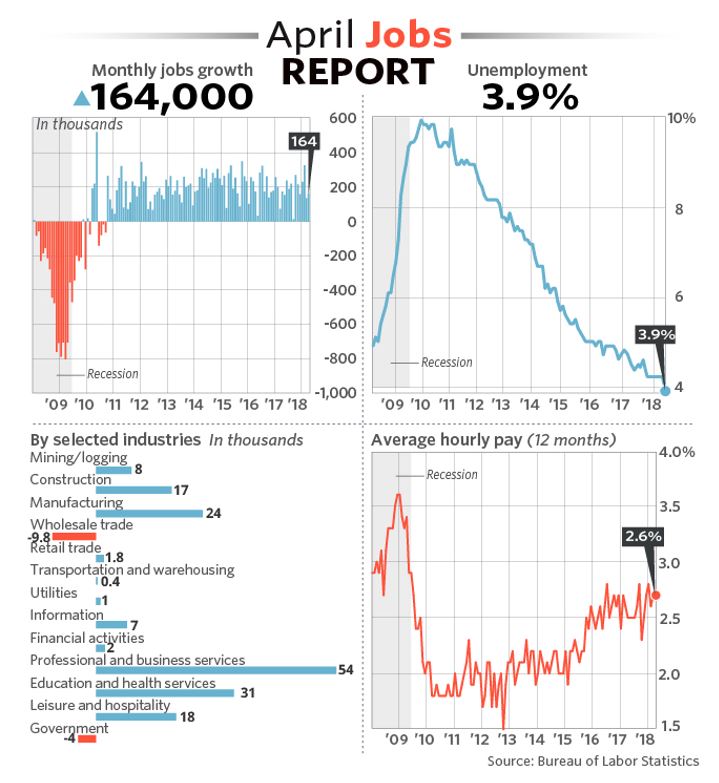From MarketWatch
The numbers: The economy generated a solid 164,000 jobs in April to push the unemployment rate below 4% for the first time since Bill Clinton was president, a sign the surging labor market shows no signs ebbing.
The increase in hiring fell short of the 188,000 forecast of economists polled by MarketWatch, but the shortfall was cushioned by upward revisions that show the U.S. created more jobs in March than originally reported.
The unemployment rate, meanwhile, slipped to 3.9% after holding at 4.1% for six months in a row. Yet the decline owed to a shrinking labor force and fewer people saying they were unemployed instead of an increase in how many people found work.
Despite the ultra-tight jobs market, wages for American workers still aren’t rising rapidly. Hourly pay rose 0.1% to $26.84, the government said Friday. The 12-month increase in pay was flat at 2.6% for the third month in a row.
The Federal Reserve is likely to view the stable rate of pay as a sign of support for its cautious strategy of raising U.S. interest rates.
What 3.9% Unemployment Tells Us About the Economy
What happened: The increase in new jobs last month was spearheaded by professional businesses. They added 54,000 workers.
Hiring also rose smartly among health-care providers and manufacturers, each of which added 24,000 jobs. Construction firms increased payrolls by 17,000.
Read: Manufacturers are pushing workers, and equipment, harder than ever
Wholesaler and government were the only sectors to shed jobs.
Big picture: After almost nine years of economic expansion, one of the biggest problems companies face is finding skilled workers to fill millions of job openings.
In some cases, firms are hiring people and training them themselves. In other cases they are resorting to more automation. And in still other situations companies try to poach employees from other firms with more lucrative pay and benefits.
The tight labor market is especially evident in what’s often called the “real” unemployment rate. The so-called U6 rate includes people who can only find part-time work and those who’ve gotten so discouraged they recently stopped looking. It fell to 7.8.% in April to drop below 8% for the first time since 2006. Now it’s almost back to normal.
Even so, the vast majority of American workers still aren’t reaping big rewards from the tightest labor market in almost two decades. Companies continue to find ways to contain costs and many customers simply are unwilling to pay higher prices for goods and services.
Read: Lack of wage acceleration is main surprise in jobs report, economists say
That can’t continue forever. Either companies will have to pay workers more — or they’ll have to increase investment to boost production.
Market reaction: The Dow Jones Industrial Average DJIA, +1.39% and Standard & Poor’s SPX, +1.28% surged in Friday trades, with the Dow up more than 350 points. The 10-year Treasury yield TMUBMUSD10Y, -0.15% were little changed at 2.94%. The April jobs report did not show any pickup in inflationary pressures that have been worrying investors.



